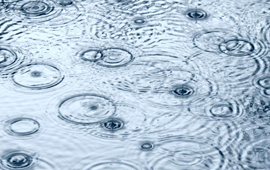Diseño y calibración de un simulador automático de lluvia
DOI:
https://doi.org/10.31644/IMASD.12.2016.a02Palabras clave:
Simulación de lluvia, Tamaño de la gota, Energía cinéticaResumen
En el presente trabajo se diseñó y construyó un simulador de lluvias utilizando materiales de bajo costo y de fácil transporte, el cual permitió controlar variables como intensidad, uniformidad y duración. Se controló el caudal con una electroválvula mediante un detector de cruce por cero, tarjeta de control y una etapa potencia. Los resultados indicaron que el comportamiento en la distribución espacial de la lluvia fue uniforme con un valor superior a 80%, intensidad de lluvia similares a episodios naturales con una energía cinética superior a 27 J/mm m2, con un control del caudal de 97% de precisión.
Descargas
Citas
A. Moussouni, L. M. (2014). The Effect of Raindrop Kinetic Energy on Soil Erodibility. International Journal of Environmental, Chemical, Ecological, Geological and Geophysical Engineering , 8 (12), 874-878.
Abudi, L., Carmi, G., & Berliner, P. (6 de August de 2012). Rainfall simulator for field runoff studies. Journal of Hydrology , 76-81.
Blanquies, J., Scharff, M., & Hallock, B. (2003). The Design and Construction of a Rainfall Simulator. International Erosion Control Association (IECA), 34th Annual Conference and Expo., Las Vegas, Nevada, February 24-28, 2003. Las Vegas, Nevada.
Benito Rueda, E., & Gomez-Ulla, A. &.-F. (1986). Descripción de un simulador de lluvia para estudios de erodabilidad del suelo y estabilidad de los agragodos al agua. Anales de Edafología y Agrobiología , XLV (9-10), 1115-1126.
Brandt, C. J. (1989). The size distribution of thoughfall drops under vegetation canopies. Catena (16), 507-524.
Carreras Nampulá, J. L., García Lara, C. M., Espinoza Medinilla, E. E., González Herrera, R., & Medina Sansón, L. (2015). Análisis de la intensidad y duración de la lluvia simulada mediante manipulación manual, para el diseño y construcción de un simulador de lluvias. Revista de Ciencias de la UNICACH , 9 (2), 73-78.
Carter, C. E., Greer, J. D., & Braud, H. J. (1974). Raindrop characteristics in south central United States. Trans. ASAE (17), 1033-1037.
Cerdá, A., & Ibañez, S. &. (1997). Design and operation of a small and portable rainfall simulator for rugged terrain. Soil Technology (11), 163-170.
Chow, W. T. (1965). Raindrop production for laboratory waterhed experimentation. J. Geophys. Res. , 70 (24), 6111-6119.
Christian Salles, J. P. (1999). Measurement of Simulated Drop Size Distribution with an Optical Spectro Pluviometer: Sample Size Considerations. Earth Surf. Process. Landforms (24), 545-556.
G. B. Paige, J. J. (2003). The Walnut Gulch Rainfall Simulator: A Computer-Controlled Variable Intensity Rainfall Simulator. Applied Engineering in Agriculture , 20 (1), 25-31.
Gopinath Kathiravelu, T. L. (2016). Rain Drop Measurement Techniques: A Review. Water , 8 (29), 20.
Grismer, M. (2012). Standards vary in studies using rainfall simulators to evaluate erosion. CALIFORNIA AGRICULTURE , 66 (3), 102-107.
Gunn, R. &. (1949). Terminal Velocity of water droplets in stagnat air. J. Meteorol. (6), 243-248.
Hudson, N. W. (1971). Soil Conservation. London: B. T. Batsford Ltd.
Hudson, N. W. (1964). The flour pellet method for measuring the size of raindrops. Department of conservation and extension. Research Bulletin (4), 1-28.
Hudson, N. W. (1961). An introduction to the mechanics of soil erosion under conditions of subtropical rainfall. Rhod. Sci. Assoc. Proc. Trans. (159), 14-25.
I. Abudi, G. C. (2012). Rainfall simulator for field runoff studies. Journal of Hydrology , 454-455, 76-81.
Ibañez Asensio, S., Moreno Ramón, H., & Gisbert Blanquer, J. (2012). El uso de un simulador de lluvia. Valencia, España: Universitat Politécnica de Valéncia.
Jau-Yau, L., Chih-Chiang, S., Tai-Fang, L., & Ming-Ming, M. (2008). Number and volume raindrop size distributions in Taiwan. Hydrological Processes , 22 (13), 2148-2158.
Kamphorst, A. (1987). A small rainfall simulator for the determination of soil erodibility. Netherlands Journal of Agricultural Science (35), 407-415.
Kinell, P. I. (1973). The problem of assessing the erosive power of rainfall from meteorological observations. Soil Sci. Soc. Amer. Proc. (37), 617-621.
L. Wanga, Z. S. (2014). Rainfall kinetic energy controlling erosion processes and sediment sorting on steep hillslopes: A case study of clay loam soil from the Loess Plateau, China. Journal of Hydrology , 512 (6), 168-176.
Laws, J. O. (1943). The relation of raindrop size to intensity. Trans. Amer. Geophys. Union (24), 452-459.
Marelli, H. J., Mir, B. M., Arce, J., & Lattanzi, A. (1984). Evaluación de erosión hídrica en suelo labrado (Vol. 8). Argentina: Suelos y Agroclimatología.
Marelli, H., Arce, J.M., & Masiero, B. (1986). Simulador de lluvias para investigación básica en conservación de suelos. Pub. Técn. No 8 , 15.
Martínez-Mena, M. D., Abadía, R., & Castillo Sánchez, V. M. (2001). Diseño experimental mediante lluvia simulada para el estudio de los cambios en la erosión del suelo durante la tormenta. C & G (15(1-2)), 31-43.
Meyer, L. D. (1958). Rainfall simulator for runoff plots. Agricultural Engineering (39), 644-648.
Meyer, L. D. (1965). The Design and Construction of a Rainfall Simulator. Trans of the ASAE , 8.
Meyer, L. D. (1979). Multiple intensity rainfall simulator for erosion research on row sid slopes. Trans of the ASAE (22), 100-103.
Moazed, H., Bavi, A., Boroomand-Nasab, S., & Naseri, A. &. (2010). Effects of climatic and hydraulic parameters on water uniformity coefficient in solid set systems. Journal of Applied Sciences (10), 1792-1796.
Morin, J., & Goldberg, D. &. (1967). A rainfall simulator with a rotating disc. Trans of the ASAE , 8 (1), 67-68.
Multchler, C. K. (1967). Parameters for describing raindrop splash. Journal of Soil and Water Conservation , 22 (3), 91-94.
Navas, A., & Alberto, F. M. (1990). Design and operation of a rainfall simulator for field studies of runoff and soil erosion. Soil Technology (3), 385-397.
Ognjen Gabric, D. P. (2014). Uncertainty assessment of rainfall simulator uniformity coefficient. Journal of Faculty of Civil Engineering , 661-667.
Parsakhoo, A., Lotfalian, M., Kavian, A., Hoseini, S., & Demir, M. (2012). Calibration of a portable single nozzle rainfall simulator for soil erodibility study in hyrcanian forests. African Journal of agricultural reseearch , 7 (27).
Rosewell, C. J. (1986). Rainfall Kinetic Energy in Eastern Australia. Journal of Climate and Applied Meteorology , 25, 1695-1701.
Rostagno, C. M. (1995). Diseño de un simulador de lluvia para estudios de infiltración y erosión de suelos. Ciencia del Suelo , 13, 41-43.
Salvador, R; Bautista-Capetillo, C; Burguete, J; Zapata, N; Serreta, A; Playán, E. (2009). A photographic method for drop characterization in agricultural sprinklers. Irrigation Science , 27 (4), 307-317.
Sanroque, P., Rubio, J. L., & Sánchez, J. (1984). Simulador de lluvia para el estudio de la erosionabilidad del suelo en el laboratorio. I Congreso de Geología, I, 788-794.
Sílvia C. P. Carvalho, J. L. (2014). Using meshes to change the characteristics of simulated rainfall produced by spray nozzles. International Soil and Water Conservation Research , 2 (2), 67-78.Wischmeier, W. H. (1958). Rainfall energy and its relationship to soil loss. Trans. Amer. Geophys. Union (39), 285-291.
Vaze, J. &. (2003). Study of pollutant washoff from small impervious experimental plots. Water Resources Research (39), n/a.
Wiesner, J. (1985). Bietraege zur Kenntniss des tropi Regens. K. Akad Will Math. Naturw. Klesse (104), 1397-1434.
























